OPINION
DBKL’s Push for energy efficiency and renewable energy
Kuala Lumpur’s 30 per cent renewable energy rule for new buildings creates solutions to meet requirements

By AUSTIN LIM
In support of the Malaysian government’s renewable energy policy, the Kuala Lumpur Mayor Datuk Seri Mahadi Che Ngah imposed a mandatory requirement that from May 2021 onwards, all future residential & commercial developments in Kuala Lumpur must rely on at least 30 per cent onsite renewable energy.
Renewable energy system design and energy calculations shall be submitted before the Development Order (DO) approval by DBKL. Moreover, all relevant documented evidence shall be attached during the issuance of Certificate Completion and Compliance (CCC).
“We recently imposed this condition in our approval process, and developers must now include this when planning their projects. We must move with the times as renewable energy is the future. Renewable energy is cleaner and helps combat greenhouse gas emissions and is better for the environment, said the Mayor.
This major leap from zero to 30 per cent of renewable energy reliance could be challenging for some projects, such as high-rise buildings or buildings with roof space constraints.
While ambitious intermediate goals are essential in the transition to 100 per cent renewable energy, it is also important not to set unattainable goals. This article looks at what it takes to achieve the 30 per cent onsite renewable energy requirement for four different building types.
Solar Photovoltaics
The most relevant renewable energy technology for buildings in Kuala Lumpur is solar photovoltaic (PV) panels or just solar panels. When placed on the roof, solar panels can annually generate about 1200 kWh/kWp, which corresponds to approximately 150 kWh of electricity per square meter of solar panel.
According to the Malaysian Sustainable Energy Development Authority (SEDA), more than 4.12 million buildings with rooftop solar panel potential in Peninsular Malaysia alone.
However, if mounted on vertical building façades, however, the annual yield of solar panels drops to about half or even lower when shaded by other buildings.
With its location in the equatorial zone, Malaysia is well suited for solar power with slight variation in solar radiation across the year.
Moreover, local grid-connected solar energy installations can alleviate stress in the local grid system, reduce transmission and distribution losses and provide a more reliable energy supply.
The versatility and simplicity of the installation of solar photovoltaic systems and a 5-fold drop in price over the last ten years are key reasons why solar systems are increasingly incorporated in new and existing building projects to lower the overall building energy demand.
Practical limit of renewable energy offset for different types of buildings
1) Low-rise residential
The average monthly energy consumption of a typical 186 m2 two-storey terrace house in the Sime Darby’s City of Elmina is 608 kWh/month. This corresponds to a building energy intensity (BEI) of 39 kWh/m2/year.
The BEI is helpful for energy benchmarking and is calculated by taking the total annual electricity consumption (kWh/year) divide by gross floor area (GFA), excluding car park area (m2). To fulfil the 30 per cent renewable energy requirement (for terrace houses), the roof space is sufficiently large, as only about 10 m2 of solar panels is needed.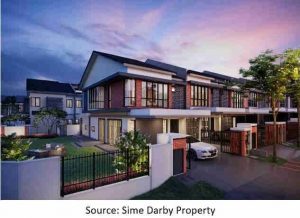
2) Low-rise non-residential (shopping mall)
For low-rise non-residential buildings, such as shopping malls, the annual energy consumption is high, typically around 400 kWh/m2/year due to extensive use of air-conditioning.
A low-rise shopping mall has a chance to meet DBKL’s 30 per cent renewable energy requirement from installing roof panels alone, but only if the building is designed to be energy-efficient.
Case in point, the energy-efficient two-storey IKEA Batu Kawan with a BEI of 159 kWh/m2/year only needs to install solar panels on 73 per cent of its roof. A typical shopping mall with twice the energy consumption would fall 88 per cent short and would have to explore whether installing additional solar panels on the façade would suffice.
For typical shopping malls, it is recommended to push energy efficiency as an easier, cheaper and sometimes necessary way to meet the 30% renewable energy requirement.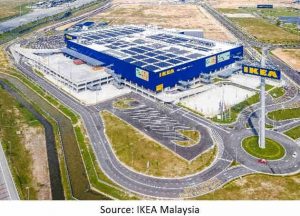
3) High-rise residential
High-rise buildings have a comparatively small roof area, making it near
impossible to rely on roof solar installations alone. As for the 42-storey KL Eco City ViiA Residences, the roof area only corresponds to three per cent of the gross floor area. With the assumption of a 70 per cent occupancy rate, the energy-efficient ViiA Residences has a BEI of 83 kWh/m2/year.
In addition to installing 1,100 m2 solar panels on the entire roof, one-third of the façade (8,840 m2) must also be installed with solar panels to meet the 30 per cent renewable energy requirement. Insofar the development had not been energy efficient, almost two-thirds of the facade would need to have solar panels.
The energy yield of façade solar panels is diminished by shading from surrounding tall buildings or trees. Therefore, it is advised to place these solar panels on the highest floors and on those facades that are relatively unobstructed by the surroundings. East facing solar panels will have slightly higher annual yields than the other orientations.
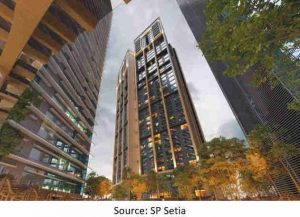
4) High-rise non-residential
High-rise commercial buildings will typically have an even higher energy consumption than residential towers, and therefore also have more difficulty meeting the 30 per cent renewable energy requirements.
Case in point, the energy-efficient 45-storey KL Eco City Mercu 2 office tower has a BEI of 104 kWh/m2/year. The 1,200 m2 roof solar panels can only cover 2.6 per cent of the building’s energy consumption, so solar panels have to be applied to a whopping 93 per cent of the facade.
This would significantly limit the amount of façade glazing for daylight and views out unless, of course, the windows themselves produce electricity. This technology is available but not yet widely used.
Had the office building been designed without energy efficiency, the BEI would be 250 kWh/m2/year. Covering the entire roof (1,200 m2) and façade (28,125 m2) with solar panels would only achieve 13 per cent renewable energy r
eliance.
In other words, energy efficiency must be pushed really hard for high-rise commercial buildings to have a chance at meeting the 30 per cent renewable energy requirement.
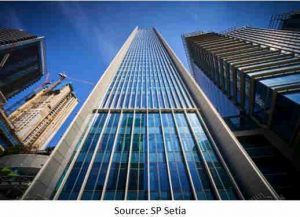
Energy Efficiency as Key Strategy
The above case studies showed that several building types will face difficulty meeting DBKL’s new onsite 30 per cent renewable energy requirement unless the buildings are designed to be energy efficient.
High-rise office buildings must be designed to be very energy-efficient with a BEI of 90 kWh/m2/year or lower, or else the building roof and façade has insufficient space for solar panels to produce the required energy.
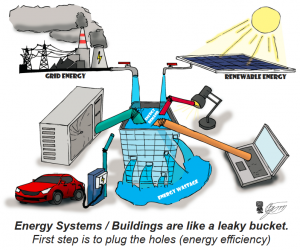 Cartoon by Bjorn Bull Hansen, IEN Consultants
Cartoon by Bjorn Bull Hansen, IEN Consultants
Buildings can be thought of as leaking buckets, where energy wastage is symbolised by leaking water (see cartoon). Instead of blindly pouring more and more water into the bucket, the leaks should be plugged in first.
In other words, the buildings should be made energy-efficient before adding solar panels. This combination of energy efficiency and renewable energy is the right and cheapest way forward to reduce energy consumption, energy costs, and carbon emissions.
Our simplified online calculator allows building designers to determine what combination of energy efficiency and renewable energy will meet DBKL’s 30 per cent renewable energy requirement: www.ien.com.my/pv-calculator
The emergence of electric vehicles, which often will be charged in the car park at offices and homes, will significantly increase the energy consumption of buildings.
This will make it even more challenging to meet DBKL’s 30 per cent renewable energy requirement in the future. For this and the reasons mentioned above, allowing for some degree of off-site renewables for some building types might be a reasonable solution going forward.
Energy-producing windows and facade panels
Instead of installing “ugly” solar panels on the façade, it is now possible to get beautiful façade integrated solar panels that do not even look like solar panels. In fact, solar panels can be printed in any design and become an aesthetic highlight of the building.
Or, more conservatively, they can look like ordinary façade panels in the colour of your choice, including glass spandrels that match the glazing colour of the rest of the building.



The technologies are AGC (first and third) and Kromatix (centre).
Energy producing windows, which have nearly invisible solar cells embedded in the glazing, are now available on the market. This product makes good sense in the tropics, where windows typically cut away half of the sun’s energy anyway.
So, why not do so with embedded solar cells and produce electricity at the same time? Windows typically make up about 30-60 per cent of the façade area, so for high-rise buildings, the use of energy-producing windows can contribute significantly to achieving DBKL’s 30 per cent renewable energy requirement.

| Solar Façade Technology | Product name | Composition | Peak Solar Energy yield (Wp/m2) |
| Vision window | Square (by AGC) | Laminate glass or IGU | 50-180 |
| Vision window | Stripe (by AGC) | Laminate glass or IGU | 55-60 |
| Glass spandrel | Lacobel Active (by AGC) | Laminate glass | 100-160 |
| Glass spandrel | Artlite Active (by AGC) | Laminate glass | 100-150 |
| Glass spandrel | Spray Active (by AGC) | Laminate glass | 130-150 |
| Façade panel | Orange, Gold, Bronze, Blue, Grey (by Kromatix) | Building Applied PV | 140-180 |
Solar façade technologies currently available on the Malaysian market
Kuala Lumpur has set a target of becoming a carbon-neutral city by 2050. Currently, 41 per cent of Kuala Lumpur’s carbon emissions come from residential (10 per cent), commercial (24 per cent) and industrial (seven per cent) buildings.
By imposing the 30 per cent renewable energy requirement, DBKL is killing two birds with one stone by effectively forcing most new buildings to implement both energy efficiency and renewable energy measures. An excellent first step on the critical journey to a fully decarbonised society.








